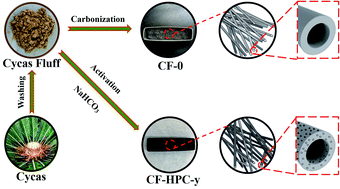Hierarchical hollow-tubular porous carbon microtubes prepared via a mild method for supercapacitor electrode materials with high volumetric capacitance
Abstract
In this paper, hollow-tubular porous carbons were synthesized from abundant biomass Cycas fluff (CF) through simple carbonization followed by an NaHCO3 mild activation process. After activation, the tubular structure of the CF was retained, and a hierarchical structure of micropores, mesopores and macropores was formed. When the optimal mass ratio of NaHCO3/CF is 2, the obtained porous carbon CF-HPC-2 sample has a large specific surface area (SSA) of 516.70 m2 g−1 in Brunauer–Emmett–Teller (BET) tests and a total pore volume of 0.33 cm3 g−1. The C, O, N and S contents of CF-HPC-2 were tested as 91.77 at%, 4.09 at%, 3.54 at%, and 0.6 at%, respectively, by elemental analysis. Remarkably, CF-HPC-2 exhibits a high volume capacitance (349.1 F cm−3 at 1 A g−1) as well as a higher rate capability than other biomass carbon materials (289.1 F cm−3 at 10 A g−1). Additionally, the energy density of the CF-HPC-2 based symmetric supercapacitor in 2 M Na2SO4 electrolyte at 20 kW kg−1 is 27.72 W h kg−1. The particular hollow tubular morphology and activated porous structure determine the excellent electrochemical performance of the material. Hence, this synthetic method provides a new way of storing energy for porous carbon as high volumetric capacitance supercapacitor materials.



 Please wait while we load your content...
Please wait while we load your content...